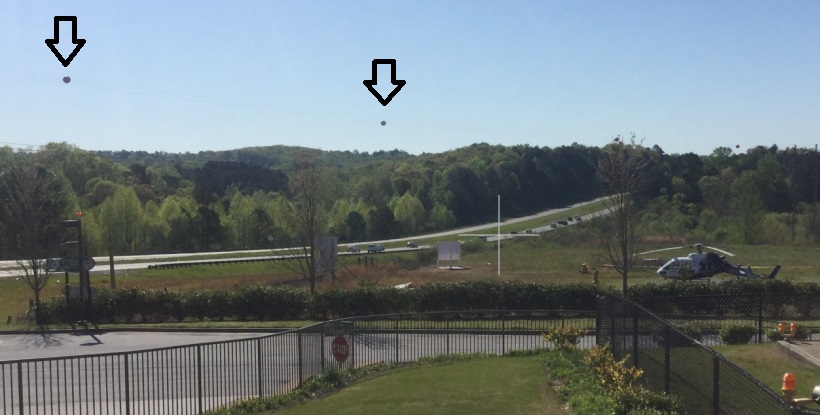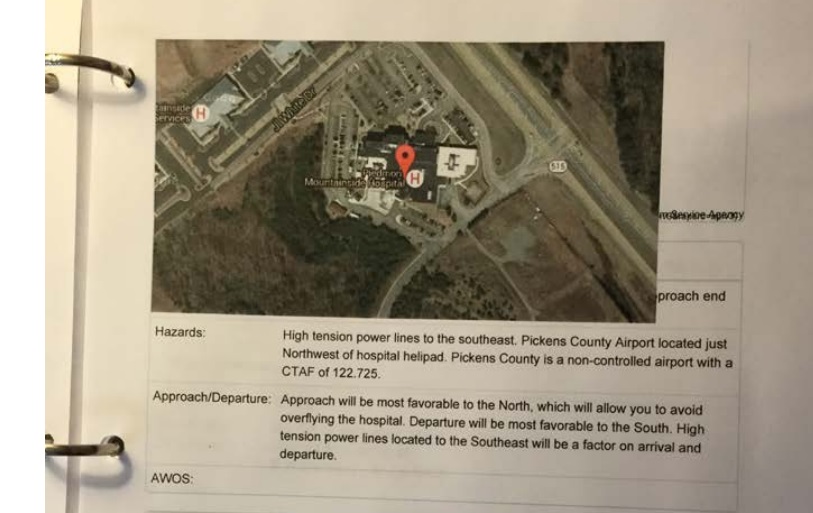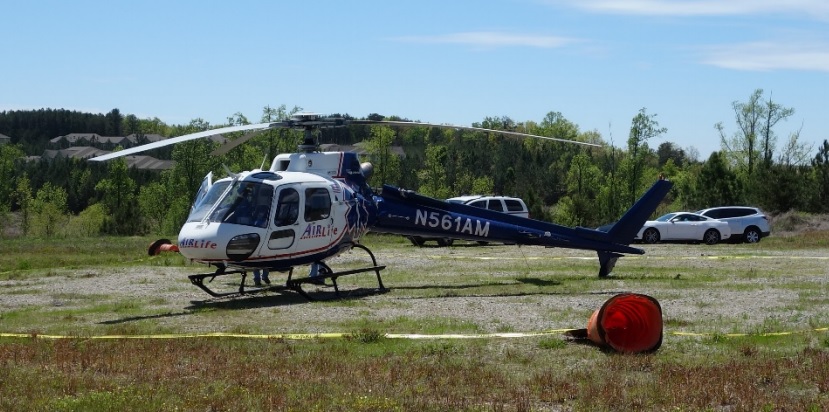Hard Landing after VRS on Approach to a Hospital Site
On 15 April 2016 a HEMS Airbus Helicopters AS350B2, N561AM, operated by Air Methods Corporation, was substantially damaged in a hard landing at the Piedmont Mountainside Hospital. Jasper, Georgia. The pilot and three medical personnel, who were inbound to collect a patient, were uninjured.
The US National Transportation Safety Board (NTSB) explain in their safety investigation report that “the helicopter completed an orbit over the hospital heliport about 800 ft agl prior to beginning a descent for landing”. In his statement the pilot explained that:
Since a trainee was aboard, I began to explain the procedures to be followed. I explained hazards found at hospitals, pointed out the windsock, and pointed out large power lines…
These lines are estimated to be about 100 ft above ground level. The NTSB explain that:
The helicopter was approaching the helipad with a direct 11-knot tailwind gusting to 16 knots [from 120°].
About 250 ft above ground level, the commercial pilot lost tail rotor and cyclic authority, and the helicopter pitched forward and accelerated toward the ground. The pilot recognized the onset of vortex ring state, reduced engine power, and attempted to initiate a go-around; however, insufficient altitude remained to complete the maneuver, and the helicopter landed hard, resulting in a partial separation of the tailboom.
Images show the aircraft on what appears to be a vacant lot SE of the helipad. The NTSB say that:
A vortex ring state may be entered during any maneuver that places the main rotor in a condition of high upflow and low forward airspeed, including near-vertical descents of at least 300 ft per minute, and a horizontal velocity slower than that for effective translational lift. A fully developed vortex ring state can be “characterized by an unstable condition in which the helicopter experiences uncommanded pitch and roll oscillations.”
According to representatives from Airbus Helicopters, the maximum allowable engine torque setting was for the helicopter was 100 percent continuous. The Vehicle Engine Multifunction Display (VEMD) was reviewed under federal supervision and the data indicated overtorque events at 107 percent for 2 seconds and 113 percent for 1 second.
So Why That Approach?
The NTSB don’t examine why the approach was flown as it was. Our first reaction was that the approach direction was influenced by the power cables the pilot mentioned. These initially appear to follow the highway, which runs NW to SE.

Powerlines (with Marker Balls Highlighted) near Piedmont Mountainside Hospital Helipad: AMC Airbus AS350B2 N561AM (Credit: FAA via NTSB)
However examination of Google Maps data, they actually run N to S (despited being described as “located to the SE” in the rather crude helipad ‘briefing document’) and thus were overflown, though perhaps forcing a steeper approach than desired.

Piedmont Mountainside Hospital ‘Helipad Briefing’ Document: AMC Airbus AS350B2 N561AM (Credit: via NTSB)
This document restrictively suggests a Northerly approach and Southerly departure “to avoid overflying the hospital”, even though strictly the building is to the NW of the helipad. With the wind from 120° an into wind approach would have been directly over the hospital. Another factor that might have influenced decision making is that the hospital is located on the perimeter of the Pickens County airport, an uncontrolled airfield, with the heliport less than 500m from the threshold of Runway 34.
NTSB Probable Cause
The pilot’s loss of helicopter control due to vortex ring state, which resulted in a hard landing.
Contributing to the accident was the pilot’s decision to conduct the landing approach with a tailwind.
Other Safety Resources
UPDATE 18 August 2018: Inappropriate Autorotation Training
UPDATE 8 September 2018: Torched Tennessee Tour Trip (B206L N16760) An ungreased fuel pump spline failed, the pilot was not able to successful autorotate, crashed and suffered a fatal post crash fire.
UPDATE 7 October 2018: Helicopter Engine Unapproved Repair Leads to Forced Landing Damage
UPDATE 21 September 2019: Mi-26T Arctic VRS Accident 28 November 2018
UPDATE 2 January 2020: EC130B4 Destroyed After Ice Ingestion – Engine Intake Left Uncovered
UPDATE 19 April 2020: SAR Helicopter Loss of Control at Night: ATSB Report
UPDATE 18 July 2020: Vortex Ring State: Virginia State Police Bell 407 Fatal Accident
UPDATE 3 October 2021: French Cougar Crashed After Entering VRS When Coming into Hover


Recent Comments